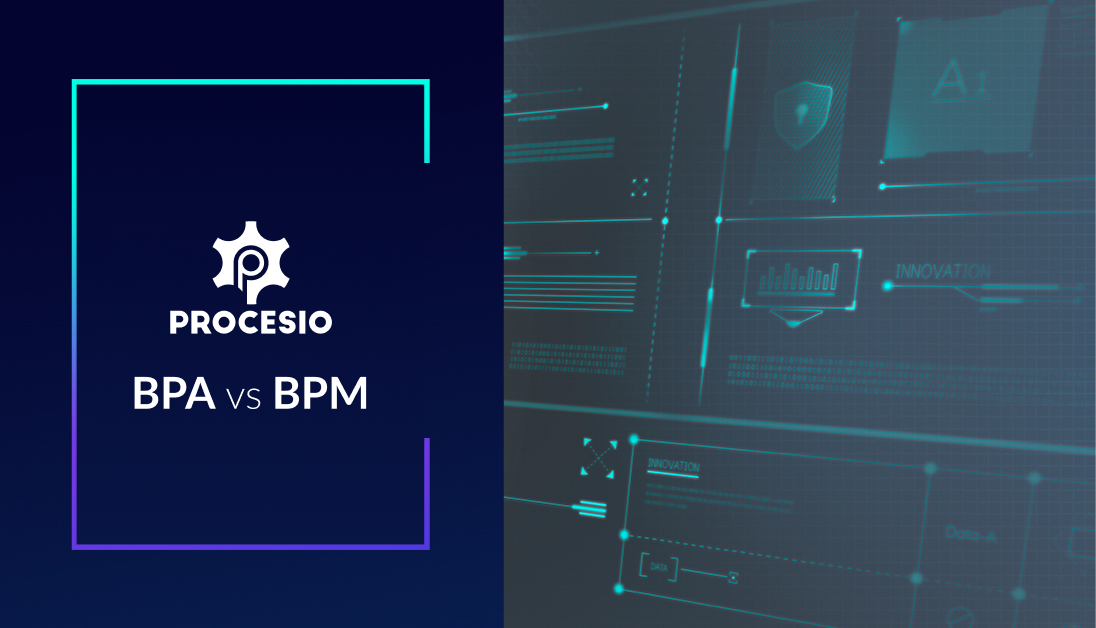With the economic hardships of the global sanitary crisis, businesses struggle to find ways to decrease operating costs and increase their efficiency and productivity. However, many companies' continuous budget restraints make it challenging to switch from a manual process to an automated one, despite the time-cost savings.
Digital transformation has been accelerated in the past year like never before. According to a 2019 IDC report, direct digital transformation investments are growing at a compound annual growth rate of 17.5% from 2020 to 2023. They are expected to approach $7.1 trillion as companies build on existing strategies.
Nevertheless, investing in emerging technologies such as AI and ML is only worthwhile if the organization knows how to take advantage of them. A set of strategies to optimize processes while saving resources is a critical part of any automation strategy. BPA and BPM are two different methods that can work together to improve the process management flow.
In this article, we'll take a closer look at each one of them, point out their differences and analyze whether they can genuinely work together or not to increase your productivity and efficiency.
Business Process Automation
Business Process Automation is an approach that employs automation. It streamlines business processes via technological solutions meant to make repetitive tasks more manageable. Not only does it allow businesses to decrease their operational costs by cutting down labor expenses, but it also allows employees to focus on what’s important. At the same time, the repetitive tasks are automatically done in the background by a robotic process. Being part of these extensive developments in technology, automation has become an answer to small and mid-sized organizations.
There are several tools and applications developed with productivity and efficiency in mind, and with that, human errors during specific processes such as data input are eliminated. From operations management and file transfers to customer support and social media management, business process automation comes to the rescue.
Business Process Management
Business Process Management is a broader and general approach compared to Business Process Automation. The focus here is not on automation but instead on the optimization of business operations. Additionally, unlike BPA, the BPM process does not identify any specific software systems used to improve processes in the workplace. The goal of BPM is to reach the maximum value and efficiency in day-to-day tasks, as it is implemented as an organization-wide policy. Furthermore, a BPM platform outlines the strategies presented across a business that relates to various tasks.
Decision-makers tend to use BPM to find inefficiencies in the workflow, find ways to improve it, and then use monitoring tools to track project management workflow. In short, BPM is used to visualize what a workflow should look like and what actions are needed to make that happen.
Usually, BPM gets confused with BPA as both of them are connected to technology. However, BPM combines both technological solutions and people into a complete improving system. In the case that it’s inefficient, it is then re-engineered from scratch.
Key differences
The two approaches have the same goal: the optimization of business processes and extracting more value out of your workflow. However, the way each does that is different, and we’re going to explain in more detail below.
Scope
Business Process Automation strives to enhance productivity via technology, but it doesn’t modify the core of the processes. Instead, it makes them more accessible and more streamlined. On the other hand, Business Process Management disrupts the workflow itself to increase performance and optimization.
Time
The time needed to put any of these approaches into place is entirely dependent on the scope. However, you don’t need to dedicate as many hours to configure the automation apps as you would need to transform entire methodologies.
Implementation
Adopting a Business Process Management takes a considerable effort, as it requires to be re-engineered from scratch in the case of inefficiency. In this case, Business Process Automation has a more straightforward setup as it only comes with software that needs to be configured depending on individual needs.
Technology
Business Process Automation is dependent on software that is strongly connected to technology. On the other hand, Business Process Management is not limited by technology since it’s one aspect of many. Additionally, it touches upon the methodology, workflow, and philosophy of the organization as well.
Impact
The impact of both of these practices is often different in each situation. It seems that Business Process Automation can have a lower result at the surface level since it’s less complex. However, that is not always the case. While many organizations can increase their profits by automating one process, it’s not uncommon to disrupt their way of doing things only to see no real impact or measurable results.
Can the two work together?
A common misconception about the BPA and BPM is that they are not mutually exclusive. One way to get the most value out of them is to implement them together. In many cases, organizations treat such software as a quick solution to fix everything, but this approach can cause confusion and decrease overall efficiency and productivity.
Additionally, to bring BPM into a company without any technical solutions is also a misconception. Since this method focuses on optimization, there is no reason to disregard automation software.
Combining both BPA and BPM into the company workflow can present many benefits. One of them is that employees can focus on improving other business processes without putting their effort into time-consuming tasks. Furthermore, knowing how to use the time saved by automation is just as important. Therefore, a joined strike force of the two should be a goal for any company.
Conclusion
Both Business Process Automation and Business Process management have the same goal, but the way they reach that goal is different. As stated in the previous paragraphs, a strategy to implement both Business Process Automation and Business Process Management needs to be put in place for a company to reach the desired efficiency and productivity.

